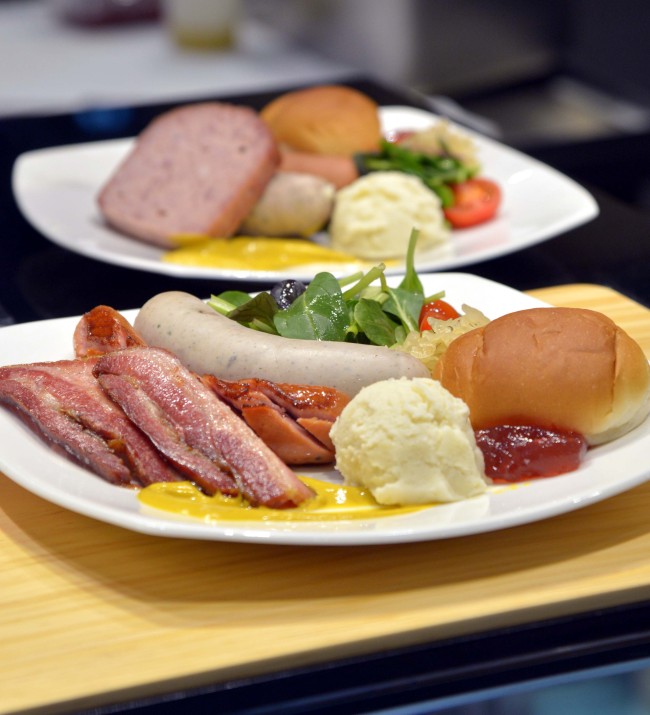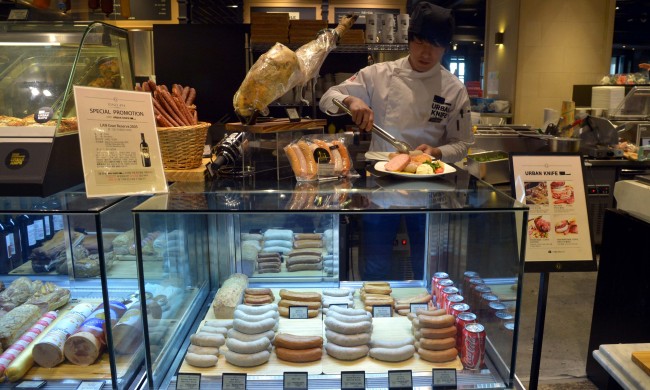Last September, a company called Korea Metzgerei Cooperation Institute, or KMCI, launched a brand called Urban Knife to help pioneer the nation’s fledgling deli market.
Urban Knife’s first brick-and-mortar space opened near Seoul’s Gangbyeon Station as a restaurant. The restaurant, according to KMCI food and beverages manager Jung Woo-sung, would serve as a launchpad for Urban Knife’s ultimate goal of opening a string of bona fide butcher shop-delis.
Later that year, that became a reality, when the government passed a law that made it easier and less expensive for butcher shops to also produce their own sausages and ham.
According to a Ministry of Food and Drug Safety representative, before then it was far more complicated and costly to do so.
For KMCI, this was good news.
According to KMCI food and beverages manager Jung Woo-sung, this meant butcher shops, which now faced lower barriers to making their own charcuterie, could purchase whole pigs, sell popular cuts like samgyeobsal (pork belly) and moksal (pork butt), and then take the remaining meat and use it to make sausages and cold cuts, a good solution for a potential surplus of less popular cuts.
 |
Housemade bacon, pepper wurst and weisswurst sausages are served up as part of the Urban Knife Classic platter. (Kim Myung-sub/The Korea Herald) |
“In a butcher shop, one can use all the parts of the pig,” Jung, 30, said, stressing the efficiency of a snout-to-tail approach, an approach that KMCI adheres to.
KMCI buys whole pigs from a partner farm in North Chungcheong Province and butchers them in-house, crafting bacon from pork belly, schweinshaxe from pork knuckles and sausages from the front and back legs, said Jung.
According to Jung, no preservatives, flour or starch are used to make their charcuterie.
“We use natural intestines, either pork or sheep casings, to make our sausages,” Jung added.
According to Jung, unlike much less expensive artificial casings, natural intestines possess great texture.
“It sort of bursts instead of just dissolving and giving away when you bite into it,” he said. “Plus, when you grill it, the casing gets very crisp on the outside.”
Up until March, Urban Knife only had one restaurant. Then, a pop-up store opened inside Galleria Department Store’s Gourmet 494. On April 1, Urban Knife will launch a permanent outlet, which Jung refers to as the brand’s first butcher-deli shop, at Galleria.
“It was a brand we were looking for,” said Galleria food and beverage team buyer Park Bo-young, who also stressed the novelty of Urban Knife. “Sausages are not that prevalent in Korea yet.”
“Ham and sausages are still a new food culture in Korea,” Jung agreed, saying how setting up shop in Gourmet 494, with its gathering of “famous eateries,” represents a challenge for them.
Urban Knife started off as a pop-up to introduce customers to the brand, said Galleria’s Park.
Now as the pop-up nears the end of its run, Urban Knife is ready to swing into full gear.
Jung pointed out the corner near the meat section of Gourmet 494 where Urban Knife will be setting up shop, gesturing to where staff will be making the sausages in a glassed-off area for passersby to watch.
Once open, the new outlet will be able to showcase all its sausages and cold cuts, of which Jung says there are around 50.
A vast majority of Urban Knife’s 50-something charcuterie boasts a German pedigree, a nod to the brand’s aspirations to become a true-to-heart “metzgerei,” which means “butcher shop” in German.
To that end, a German charcuterie meister helped develop Urban Knife’s sausages and cold cuts.
Amongst the resulting selection of German sausages, the fragrant, parsley-flecked Bavarian-style weisswurst and its other white-hued companions seem to be some of Urban Knife’s specialties, along with the reddish-brown pepper wurst, which is liberally spiced with whole peppercorns.
Then there is Urban Knife’s luscious bacon, which has been brined for three to five days and then smoked for two hours.
Some of the bacon is then cooked while some of it is dried for three months. Both versions are incredibly buttery and rich, with the dried bacon presented in near-transculent slices that virtually melt in one’s mouth.
Urban Knife’s smoked pepper salami is equally delicious, especially when cut into thick slices and given a short stint in a skillet, so that a fatty crisp crust forms around the edges.
Jung revealed plans to continue to develop more charcuterie and to also open three more outlets this year, including one in Busan.
In addition to growing Urban Knife as a business, KMCI is also geared towards sharing its know-how. While developing Urban Knife, KMCI also created an institute to train people how to make charcuterie.
“Our aim is to work together to help develop the culture and market for charcuterie,” said Jung.
 |
Urban Knife’s pop-up at Galleria’s Gourmet 494 is just the prequel to its permanent butcher-deli shop, which is slated to open on April 1. (Kim Myung-sub/The Korea Herald) |
Urban Knife in Gourmet 494
● 494 Apgujeong-dong, Gangnam-gu, Seoul
● urbanknife.co.kr; www.gourmet 494.com
● Charcuterie costs 1,800 won to 4,900 won per 100 grams, Urban Knife platters cost 10,000 won to 30,000 won, schweinshaxe costs 25,000 won
By Jean Oh (
oh_jean@heraldcorp.com)









